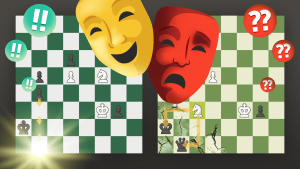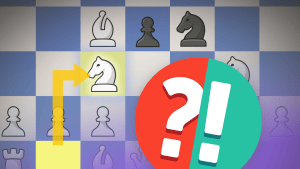
Bronstein's Recipe For Attacks
Most of the classical attacking games have a similar scenario: the winner brings his pieces close to the opponent's king and then sacrifices something to deliver a winning combination. But what can you do if your pieces are far away from your opponent's king?
If you just start moving them towards the target it will give your opponent time to prevent your plan. Here is the recommendation of the grandmaster David Bronstein from his Chess Textbook. He notes that in open positions it is very desirable to have all your pieces participating in an attack, but usually you don't have enough time to do it. Therefore, it is very common that you have to sacrifice a pawn or a piece in order to gain time to bring the pieces for an attack.

Bronstein via Wikipedia.
While this recommendation is very simple and logical, sometimes it is very difficult to sacrifice material without a clear follow-up that completely destroys your opponent's defense. Let me give you some examples that illustrate the point. Look at the following classical games:
While such combinations frequently involve a lot of calculations, psychologically it is much easier to sacrifice material when you feel it is going to be check, check, checkmate! Now compare it to Bronstein's famous combination:
As you can see, in this game Bronstein calmly kept moving his pieces towards black king after the initial spectacular sacrifice 14. Bxh6!! It is not easy to play like this since you must believe in the attacking potential of your position.
Here is one more example of such an attack where Black couldn't organize a defense because the position of his king was compromised by White's knight sacrifice.
Regardless which attacking setup you prefer -- "bring the pieces-sacrifice-checkmate" or "sacrifice-bring the pieces-checkmate" -- I hope you have noticed the essential element of a successful attack: you need to bring as many pieces for an attack as possible.
Ideally you want to employ all your pieces, or as I like to explain it to my younger students, "bring everyone to the party"!
Even bad guys know this rule:
Generally it is more difficult to play the setup "sacrifice first then bring the pieces," because as a rule your opponent has a variety of defensive moves. Frequently it is impossible to calculate all of them, so in most of the cases you should just trust your intuition.
Look at the next beautiful game. I am absolutely sure that GM Lenderman followed his intuition when he started his attack, because even now it is difficult to say if the sacrifice was absolutely sound.
Yes, it is very difficult and risky to play like this, but GM Bronstein has another piece of wisdom for you.
He insists that it is much easier to attack than defend in positions like this. First of all the attacker has a psychological advantage and also in the case of emergency it is almost always possible to force a draw with a perpetual check.
Happy king hunting!

